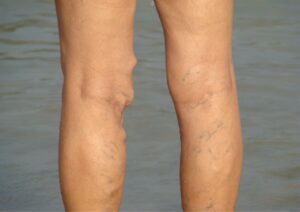Foot veins can become more prominent for various reasons, leading to questions and concerns about their appearance and potential health implications. This blog aims to address common questions related to visible veins in the feet, spider veins, and varicose veins, and offers insights into their causes and treatments.
Why Are My Veins Showing in My Feet?
Visible veins in the feet can be due to several factors:
Thin Skin: As you age, your skin becomes thinner, making veins more noticeable.
Weight and Exercise: Low body fat and regular exercise can also make veins more prominent.
Temperature Changes: Hot weather can cause veins to dilate, making them more visible.
Prolonged Standing or Sitting: These positions can increase pressure in the veins, leading to more prominent veins.
Sometimes, visible veins can be abnormal veins that require medical attention to prevent complications.
Are Spider Veins in the Feet and Ankles a Reason for Concern?
Spider veins are small, dilated blood vessels that appear near the surface of the skin. While they are generally harmless and primarily a cosmetic concern, they can sometimes indicate underlying venous insufficiency, especially if accompanied by symptoms like swelling, pain, or heaviness in the legs. In some cases, spider veins can be a sign of chronic venous insufficiency, a condition where the disrupted exchange of oxygen, nutrients, and waste products with the blood over a long period of time can lead to the development of varicose veins, deep vein thrombosis, and venous ulcers.
What is the Difference Between Varicose Veins and Spider Veins in Feet?
Varicose Veins: A varicose vein is a larger, swollen vein that often appears twisted and bulging. They are caused by weakened valves in the veins that allow blood to pool.
Spider Veins: These are smaller, red, blue, or purple veins that appear closer to the surface of the skin and resemble spider webs or branches. They are less severe than varicose veins but can be a sign of similar underlying issues.
What Do Spider Veins on Your Feet Mean?
Spider veins on the feet can indicate increased pressure in the veins, often due to prolonged standing, obesity, pregnancy, or hormonal changes. They might also suggest early stages of venous insufficiency, where the veins have trouble sending blood from the legs back to the heart. Additionally, blood clots can contribute to the formation of spider veins, highlighting the importance of medical attention and preventative measures.
What Causes Varicose Veins in the Foot?
Several factors can contribute to how varicose veins develop in the foot:
Genetics: A family history of varicose veins increases the risk.
Age: Vein walls and valves can weaken over time.
Obesity: Extra weight puts more pressure on the veins.
Prolonged Standing or Sitting: These positions can lead to increased vein pressure.
Pregnancy: Increased blood volume and hormonal changes can affect vein function.
How Do I Stop My Feet from Being Veiny and Developing Varicose Veins?
Preventing and reducing the visibility of veins in the feet involves lifestyle changes and proactive measures:
Exercise Regularly: Physical activity improves circulation and strengthens vein walls.
Maintain a Healthy Weight: Reducing excess weight can lessen pressure on your veins.
Elevate Your Legs: Elevating your feet can help improve blood flow and reduce pressure in the veins.
Wear Compression Stockings: These garments help support vein function and improve circulation.
Avoid Prolonged Standing or Sitting: Take breaks to move around and shift positions frequently.
Treating varicose veins early is important to prevent complications and may involve self-care, referral to a vascular specialist, or private treatment for cosmetic reasons.
How Are Varicose Veins in the Feet Treated?
Treatment options for varicose veins in the feet include:
Lifestyle Changes: Regular exercise, weight management, and leg elevation.
Compression Stockings: These help improve blood flow and reduce symptoms.
Sclerotherapy: A procedure where a solution is injected into the veins, causing them to collapse and fade.
Laser Therapy: Uses laser light to close off the veins.
Radiofrequency Ablation: Involves using heat to close off varicose veins.
Varicose Vein Surgery: In severe cases, surgical options like vein stripping or ligation may be necessary. These procedures may involve making small incisions along the affected vein. However, there is a risk of deep vein thrombosis as a potential complication of varicose vein surgery.
Conclusion
Visible veins in the feet, including spider and varicose veins, can be caused by a variety of factors and might indicate underlying venous issues. Understanding the differences between these conditions and knowing when to seek treatment is crucial for maintaining healthy veins. If you are concerned about the appearance of veins in your feet or experience related symptoms, consult with a healthcare professional to explore appropriate treatment options. Seeking treatment is important to prevent complications such as venous ulcers, which can result from increased pressure in the veins of the lower leg. Regular exercise, maintaining a healthy weight, and using compression stockings can help manage and prevent vein issues.









